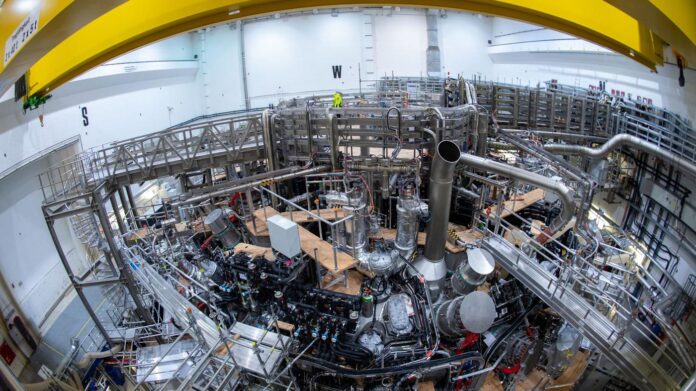
It took six months just to restart the plant – now, starting Tuesday, new tests with the large-scale Greifswald experiment “Wendelstein 7-X” are to provide further foundations for energy generation using nuclear fusion. This could one day produce huge amounts of energy without CO2 emissions and without the safety risks and waste problems of nuclear fission – or so the hope goes.
On the way there, “Wendelstein 7-X” reached a milestone during the last experimental phase in early 2023. It succeeded in maintaining a plasma – a kind of fourth state of matter required for nuclear fusion – very hot and for a long time (eight minutes). Now, above all, it is supposed to get even hotter. The facility has been technically improved for this purpose.
Nuclear fusion is the sun’s source of energy. In it, atomic nuclei fuse under great pressure and heat, releasing huge amounts of energy that also supplies the earth. For the whole thing to work on earth, temperatures of more than 100 million degrees are needed.
Preparation like before a rocket launch
The preparations for the upcoming experimental phase were like those for a “rocket launch,” according to the Max Planck Institute for Plasma Physics, to which “Wendelstein 7-X” belongs. For example, special magnets that hold the plasma had to be cooled to minus 270 degrees.
Around 740 experimental proposals were received from all over the world. 200 of these were given the highest priority for implementation. Around 100 plasma researchers and around 200 engineers and technicians are working on site. During the experimental phase, another 50 plasma researchers from Europe, the USA and Japan will be joining.
Continuous operation as a goal
According to the institute, the facility, which weighs around 1,000 tons and is located in a multi-story hall in the east of Greifswald, is one of the world’s leading facilities when it comes to the long-term generation of hot plasma. The aim is to position the institute at the top with the upcoming program. The experiments will initially run until December and then again from February to May. After another maintenance phase, a plasma duration of half an hour is to be attempted in 2026 or 2027, which would practically correspond to continuous operation and should thus create the basis for possible power plants.
Too expensive and too late?
Including investments, operating costs and personnel costs, “Wendelstein 7-X” has already cost more than a billion euros. Critics say nuclear fusion is too expensive and will come too late, if it comes at all. Thomas Klinger, head of “Wendelstein 7-X”, objects: “The restructuring of our energy system is a task for the century that will not be completed when we achieve greenhouse gas neutrality in 2045”. Demand will continue to rise. An additional option such as nuclear fusion is good. “If we do not research it now, it will not be available to humanity when it is needed.”
© dpa-infocom, dpa:240907-930-225616/1
This is a message directly from the dpa news channel.
